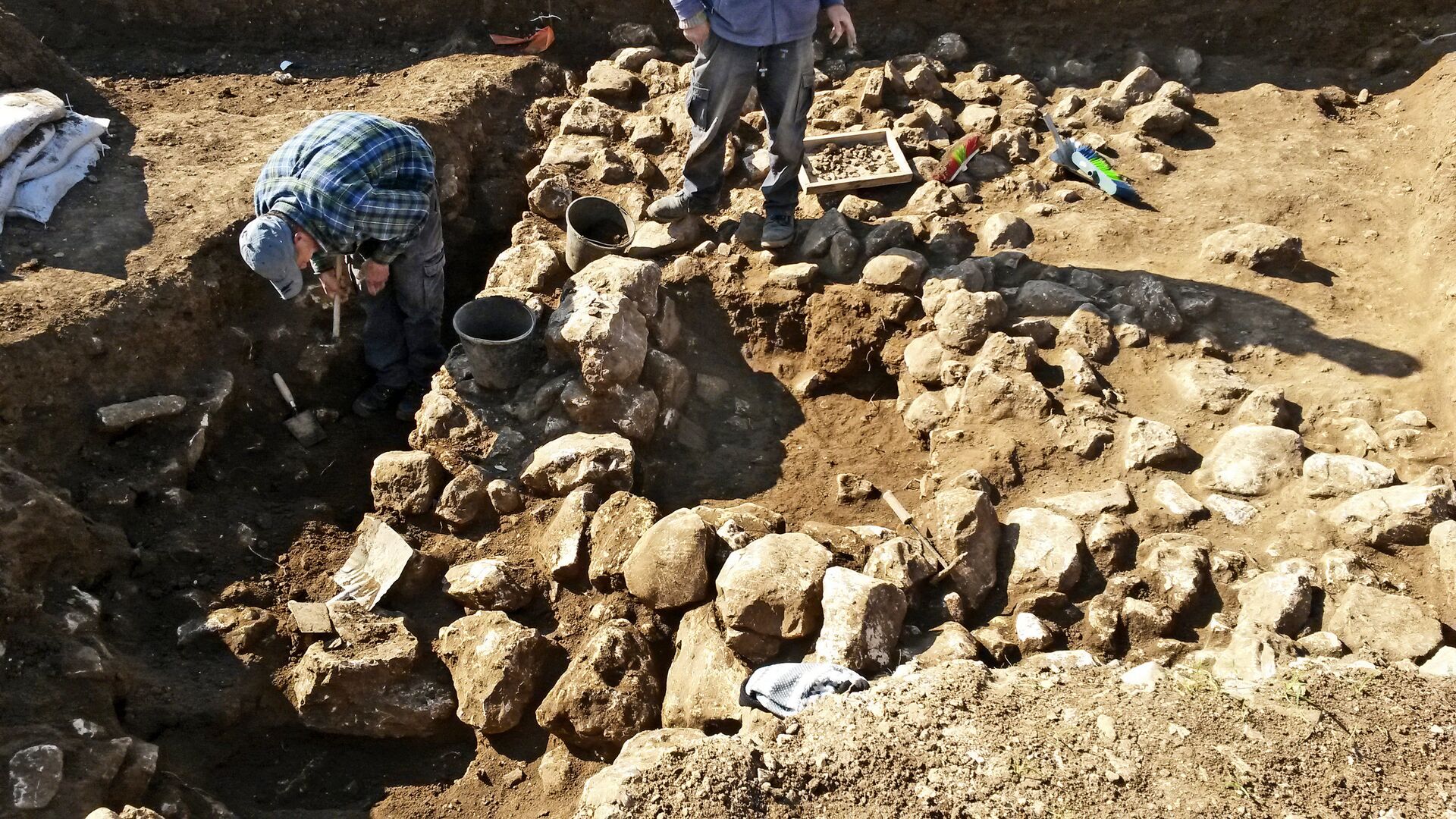https://sputnikglobe.com/20240217/1800-year-old-ancient-roman-soldiers-camp-discovered-at-armageddon-1116827309.html
1,800-Year-Old Ancient Roman Soldiers' Camp Discovered at 'Armageddon'
1,800-Year-Old Ancient Roman Soldiers' Camp Discovered at 'Armageddon'
Sputnik International
The 1,800-year-old military camp accommodated over 5,000 soldiers from the Roman army’s 6th Ironclad Legion at Tel Megiddo's foothills in northern Israel.
2024-02-17T10:18+0000
2024-02-17T10:18+0000
2024-02-17T10:18+0000
world
newsfeed
society
jerusalem
israel antiquities authority
daily mail
israel
https://cdn1.img.sputnikglobe.com/img/106057/51/1060575158_0:0:3264:1836_1920x0_80_0_0_5beba4a1d9f7ba5cfd67adf8c63b253e.jpg
An ancient Roman legionaries' camp has been found at Armageddon, believed to be the site of the final biblical battle, the Daily Mail reports.Tel Megiddo is named in the 1st century AD Book of Revelation as a place where the kings of the world, egged on by devils, will battle before God’s wrath is unleashed. The place's original name is "Har Megiddo" in Hebrew (lit. Mount Megiddo), but it was rendered as "Harmagedon" in Greek, later altered to the proverbial Armageddon.Archaeological works on the site have shown it was the biggest Roman army base ever found in modern-day Israel, accommodating thousands of troops for almost two centuries.At the heart of the camp was a junction of two main roads, serving as the reference point for distances along the Royal Imperial routes to major cities in the northern region of ancient Israel, marked out with milestones.The camp was discovered accidentally during public works by the Netivei Israel National Infrastructure Company to improve a nearby roadWithin the site's confines, archeologists unearthed ruins of a public building, ancient coins, pottery and weapon fragments and pieces of glass. They found a podium and numerous roof tiles, some of which bore markings indicative of the legion's emblem. They also identified the campsite's main road, the Via Pretoria.The excavations have gone through six seasons so far, exposing sections adjoining the commanders' courtyard.
https://sputnikglobe.com/20231106/massive-trove-of-50000-roman-coins-spotted-by-italian-diver---photos-1114769818.html
jerusalem
israel
Sputnik International
feedback@sputniknews.com
+74956456601
MIA „Rosiya Segodnya“
2024
Chimauchem Nwosu
https://cdn1.img.sputnikglobe.com/img/07e7/09/01/1113046371_0:99:1536:1635_100x100_80_0_0_9c5c627283eca931c39fe4852bbb301c.jpg
Chimauchem Nwosu
https://cdn1.img.sputnikglobe.com/img/07e7/09/01/1113046371_0:99:1536:1635_100x100_80_0_0_9c5c627283eca931c39fe4852bbb301c.jpg
News
en_EN
Sputnik International
feedback@sputniknews.com
+74956456601
MIA „Rosiya Segodnya“
Sputnik International
feedback@sputniknews.com
+74956456601
MIA „Rosiya Segodnya“
Chimauchem Nwosu
https://cdn1.img.sputnikglobe.com/img/07e7/09/01/1113046371_0:99:1536:1635_100x100_80_0_0_9c5c627283eca931c39fe4852bbb301c.jpg
armageddon, tel megiddo, ancient roman camp, ancient roman troops in israel, archeological findings at tel megiddo, 6th ironclad legion of the ancient roman army.
armageddon, tel megiddo, ancient roman camp, ancient roman troops in israel, archeological findings at tel megiddo, 6th ironclad legion of the ancient roman army.
1,800-Year-Old Ancient Roman Soldiers' Camp Discovered at 'Armageddon'
The 1,800-year-old military camp accommodated over 5,000 soldiers from the Roman army’s 6th Ironclad Legion at Tel Megiddo's foothills in northern Israel.
An ancient Roman legionaries' camp has been found at Armageddon, believed to be the site of the final biblical battle, the Daily Mail reports.
Tel Megiddo is named in the 1st century AD Book of Revelation as a place where the kings of the world, egged on by devils, will battle before God’s wrath is unleashed.
The place's original name is "Har Megiddo" in Hebrew (lit. Mount Megiddo), but it was rendered as "Harmagedon" in Greek, later altered to the proverbial Armageddon.
Archaeological works on the site have shown it was the biggest Roman army base ever found in modern-day Israel, accommodating thousands of troops for almost two centuries.
"The camp was the permanent military base for over 5,000 Roman soldiers for more than 180 years, from 117-120 to about 300 AD," said Dr. Yotam Tepper, who directed the excavation for Israel Antiquities Authority.
At the heart of the camp was a junction of two
main roads, serving as the reference point for distances along the Royal Imperial routes to major cities in the northern region of ancient Israel, marked out with milestones.

6 November 2023, 17:12 GMT
The camp was discovered accidentally during public works by the Netivei Israel National Infrastructure Company to improve a nearby road
Within the site's confines, archeologists
unearthed ruins of a public building, ancient coins, pottery and weapon fragments and pieces of glass. They found a podium and numerous roof tiles, some of which bore markings indicative of the legion's emblem. They also identified the campsite's main road, the Via Pretoria.
The excavations have gone through six seasons so far, exposing sections adjoining the commanders' courtyard.






